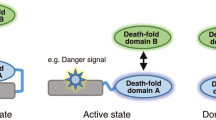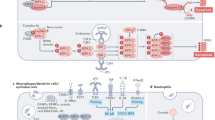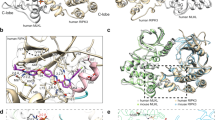Abstract
PROGRAMMEDcell death (apoptosis) mediated by the cytokine receptor Fas is critical for the removal of autoreactive T cells1, the mechanism of immune privilege2,3, and for maintenance of immune-system homeostasis4. Signalling of programmed cell death involves the self-association of a conserved cytoplasmic region of Fas called the death domain5–7 and interaction with another death-domain-containing protein, FADD8 (also known as MORT1)9. Although death domains are found in several proteins10, their three-dimensional structure and the manner in which they interact is unknown. Here we describe the solution structure of the Fas death domain, as determined by NMR spectroscopy. The structure consists of six antiparallel, amphi-pathic α-helices arranged in a novel fold. From the structure and from site-directed mutagenesis, we have identified the region of the death domain involved in self-association and binding to the downstream signalling partner FADD.
This is a preview of subscription content, access via your institution
Access options
Subscribe to this journal
Receive 51 print issues and online access
$199.00 per year
only $3.90 per issue
Buy this article
- Purchase on Springer Link
- Instant access to full article PDF
Prices may be subject to local taxes which are calculated during checkout
Similar content being viewed by others
References
Ju, S.-T. et al. Nature 373, 444–448 (1995).
Bellgrau, D. et al. Nature 377, 630–632 (1995).
Griffith, T. S., Brunner, T., Fletcher, S. M., Green, D. R. & Ferguson, T. A. Science 270, 1189–1192 (1995).
Nagata, S. & Goldstein, P. Science 267, 1449–1456 (1995).
Tartaglia, L A., Ayres, T. M., Wong, G. H. W. & Goeddel, D. V. Cell 74, 845–853 (1993).
Itoh, N. & Nagata, S. J. Biol. Chem. 268, 10932–10937 (1993).
Boldin, M. P. et al. J. Biol. Chem. 270, 387–391 (1995).
Chinnaiyan, A. M., O'Rourke, K., Tewari, M. & Dixit, V. M. Cell 81, 505–512 (1995).
Boldin, M. P. et al. J. Biol. Chem. 270, 7795–7798 (1995).
Feinstein, E., Kimchi, A., Wallach, D., Boldin, M. P. & Varfolomeev, E. Trends Biochem. Sci. 20, 342–344 (1995).
Sato, T., Irie, S., Kitada, S. & Reed, J. C. Science 268, 411–415 (1995).
Kleywegt, G. J. & Jones, T. A. Structure 3, 535–540 (1995).
Hsu, H., Xiong, J. & Goeddel, D. V. Cell 81, 535–540 (1995).
Stanger, B. Z., Leder, P., Lee, T. L., Kim, E. & Seed, B. Cell 81, 513–523 (1995).
White, K. et al. Science 264, 677–683 (1994).
Goldstein, P., Marguet, D. & Depraetere, V. Cell 84, 185–186 (1995).
Watanabe–Fukunaga, R., Brannan, C. I., Copeland, N. G., Jenkins, N. A. & Nagata, S. Nature 356, 314–317 (1992).
Yamazaki, T., Lee, W., Arrowsmith, C. H., Muhandiram, D. R. & Kay, L. E. J. Am. Chem. Soc. 116, 11655–11666 (1994).
Clore, G. M. & Gronenbom, A. M. Meth. Enzymol. 239, 349–363 (1994).
Neri, D., Szyperski, T., Otting, G., Senn, H. & Wüthrich, K. Biochemistry 28, 7510–7516 (1989).
Vuister, G. W. & Bax, A. J. Am. Chem. Soc. 115, 7772–7777 (1993).
Kuszewski, J., Nilges, M. & Brünger, A. T. J. Biomol. NMR 2, 33–56 (1992).
Brünger, A. T. X-PLOR 3.1 Manual (Yale Univ. Press, New Haven, 1992).
Kim, J.-S. & Raines, R. T. Protein Sci. 2, 348–356 (1993).
Dillon, P. J. & Rosen, C. A. BioTechniques 9, 298–300 (1990).
Nilges, M., Clore, G. M. & Gronenbom, A. M. FEBS Lett. 229, 317–324 (1988).
Brooks, B. R. et al. J. Comput. Chem. 4, 187–217 (1983).
Carson, M. J. J. Mòl. Graph. 5, 103–106 (1987).
Bradford, M. M. Anal. Biochem. 72, 248–254 (1976).
Itoh, N. et al. Cell 66, 233–243 (1991).
Author information
Authors and Affiliations
Rights and permissions
About this article
Cite this article
Huang, B., Eberstadt, M., Olejniczak, E. et al. NMR structure and mutagenesis of the Fas (APO-1/CD95) death domain. Nature 384, 638–641 (1996). https://doi.org/10.1038/384638a0
Received:
Accepted:
Issue Date:
DOI: https://doi.org/10.1038/384638a0
This article is cited by
-
ALPS, FAS, and beyond: from inborn errors of immunity to acquired immunodeficiencies
Annals of Hematology (2022)
-
Targeting apoptosis in cancer therapy
Nature Reviews Clinical Oncology (2020)
-
Comprehensive review of ASC structure and function in immune homeostasis and disease
Molecular Biology Reports (2020)
-
Plagioneurin B, a potent isolated compound induces apoptotic signalling pathways and cell cycle arrest in ovarian cancer cells
Apoptosis (2018)
-
Assembly and regulation of ASC specks
Cellular and Molecular Life Sciences (2017)
Comments
By submitting a comment you agree to abide by our Terms and Community Guidelines. If you find something abusive or that does not comply with our terms or guidelines please flag it as inappropriate.



